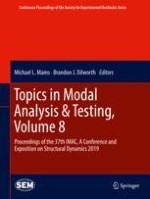2020 | Buch
Topics in Modal Analysis & Testing, Volume 8
Proceedings of the 37th IMAC, A Conference and Exposition on Structural Dynamics 2019
herausgegeben von: Michael L. Mains, Dr. Brandon J. Dilworth
Verlag: Springer International Publishing
Buchreihe : Conference Proceedings of the Society for Experimental Mechanics Series
